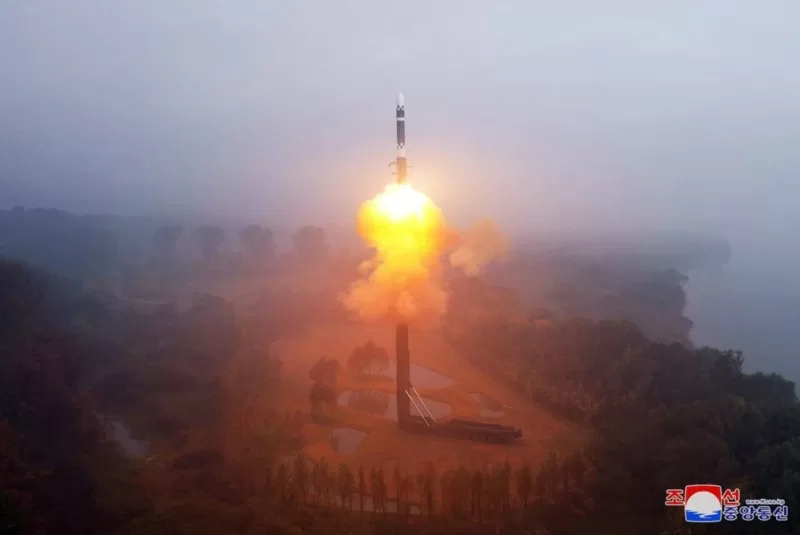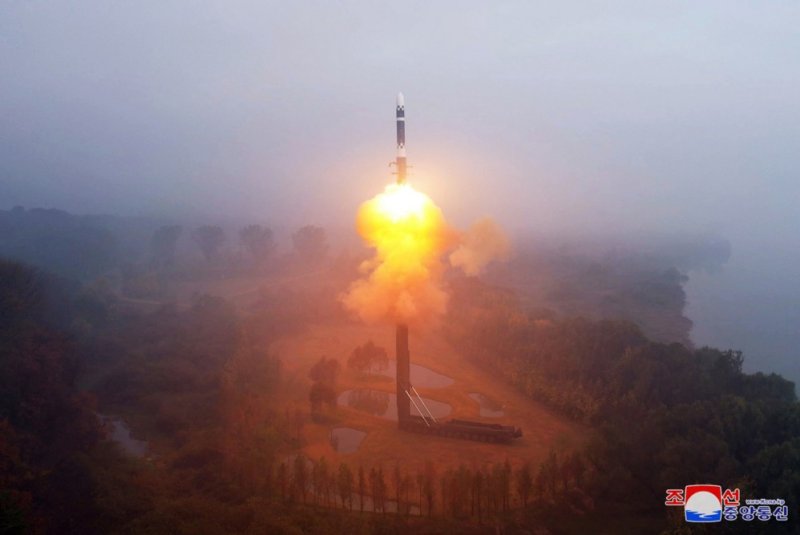North Korea’s new Hwasong-19 ICBM is the regime’s most powerful long-range missile and offers an “irreversible” means of delivering nuclear weapons, state-run media said Friday. Photo by KCNA/EPA-EFE
SEOUL, Nov. 1 (UPI) — North Korea successfully test-fired its new Hwasong-19 intercontinental ballistic missile, state-run media reported Friday, with leader Kim Jong Un claiming the regime has secured an “irreversible” means of delivering nuclear weapons.
Kim said the launch demonstrated the missile’s “matchless strategic nuclear attack capability before the world,” according to a report in the official Korean Central News Agency.
The Hwasong-19, which was fired on Thursday, flew for 86 minutes and reached an altitude of 4,776 miles, KCNA said — both records for a North Korean missile.
“The test of the latest strategic weapon system updated the recent records of the strategic missile capability of the DPRK and demonstrated the modernity and credibility of its world’s most powerful strategic deterrent,” the KCNA report said.
The Democratic People’s Republic of Korea is the official name of North Korea.
The militaries of South Korea and Japan tracked the launch in real time Thursday and reported similar flight data.
“So far, the initial judgment is that it may have been a test launch of a new solid-propellant long-range ballistic missile,” South Korean Defense Ministry spokesman Lee Kyung-ho said at a press briefing Thursday.
Missiles using solid-fuel propellants have long been on Kim’s wish list of weapons as they can be transported and launched more quickly than liquid-fuel models.
The North’s previous solid-fuel ICBM, the Hwasong-18, was first tested in April 2023 and is believed to have the capacity to reach anywhere in the continental United States.
The new missile appears to be substantially larger than its predecessor. Images released by state media show the Hwasong-19 mounted on an 11-axle transporter-erector launcher while the Hwasong-18 uses a 9-axle TEL.
However, it is still unclear whether Pyongyang has the atmospheric re-entry vehicle technology to successfully deliver a nuclear payload with its ICBMs.
The missile test comes as North Korea has dispatched troops to Russia to assist Moscow’s war against Ukraine.
On Thursday, U.S. Secretary of State Antony Blinken said that some 8,000 North Korean soldiers have moved to the border with Ukraine and may soon be deployed on the battlefield.
“We now assess that there are some 10,000 North Korean soldiers in total in Russia, and the most recent information indicates that as many as 8,000 of those North Korean forces have been deployed to the Kursk Region,” Blinken said at a press briefing in Washington.
The remarks came at a meeting at the State Department with U.S. Defense Secretary Lloyd Austin, South Korean Foreign Minister Cho Tae-yul and Defense Minister Kim Yong-hyun.
“We’ve not yet seen these troops deploy into combat against Ukrainian forces, but we would expect that to happen in the coming days,” Blinken said.
South Korean defense officials warned earlier this week that North Korea was looking to stage a provocation ahead of the U.S. presidential election on Tuesday.
On Friday, the South’s Ministry of Unification, which oversees inter-Korean relations, echoed the assessment and added that the North may also want to distract attention from its troops in Russia.
“We believe that the launch may have had various purposes, such as demonstrating nuclear and missile capabilities and pressuring the United States, as well as diverting attention from the issue of sending North Korean troops to Russia,” ministry spokeswoman Kim In-ae said at a press briefing.
The United States, South Korea and Japan issued a joint statement condemning the test, saying the launch was North Korea’s latest violation of multiple U.N. Security Council resolutions that restrict the regime’s illicit nuclear and ballistic missile programs.
“We deplore the DPRK’s decision to divert its scarce resources away from its people to these unlawful weapons programs,” the statement said.
“The ROK, U.S. and Japan condemn in the strongest terms deepening military cooperation between the DPRK and Russia, including continued unlawful arms transfers, as well as the recent deployment of North Korean troops to Russia,” the statement added.

